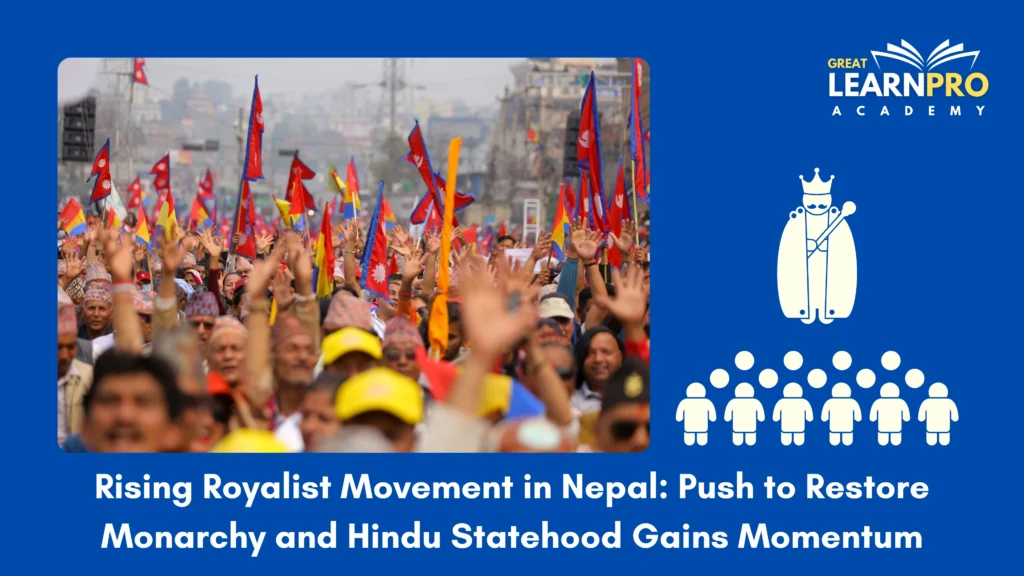
Nearly two decades after Nepal transitioned to a secular republic with the abolition of its monarchy in 2008, a powerful pro‑monarchy movement has resurfaced, driven by deep public frustration with political instability, corrupt governance, and the perceived failure of democratic institutions.
Origins and Drivers of the Revival
Nepal’s monarchy, which endured for more than 200 years, was dismantled after mass protests ended King Gyanendra Shah’s authoritarian rule and ushered in a republic. Since then, Nepal has seen over a dozen different governments, with successive administrations failing to deliver stable leadership or economic progress. Against this backdrop of frustration, many Nepalis are now expressing nostalgia for a constitutional monarchy aligned with Hindu national identity.
In February 2025, former King Gyanendra released a video message on a national holiday urging citizens to rally behind a renewed movement for unity, peace, and development. His pilgrimage across western Nepal through Pokhara, Galeshwar Dham, and Baglung Kalika drew massive crowds chanting slogans such as “Raja aau, Desh bachau” (“King must come to save the nation”).
Movement Structure and Leadership
Initially fragmented, pro‑monarchist groups have consolidated under the Joint People’s Movement Committee, coordinated by veteran Panchayat-era leader Nabaraj Subedi. This coalition includes prominent factions of the Rastriya Prajatantra Party (RPP), led by Rajendra Lingden and Kamal Thapa, as well as former Maoist guerilla-turned-royalist Durga Prasai. Over 44 royalist and Hindu nationalist groups have joined the new unified front, pledging to press for restoration until success.
The RPP now formally supports a constitutional monarchy with a ceremonial king, a Hindu republic framework, scrapping provinces in favor of a simplified federal structure, and launching a high-level judicial commission to probe corruption among public officials since the 1990s.
Mass Mobilizations and Escalations
On March 9, 2025, around 10,000 supporters welcomed Gyanendra’s return to Kathmandu, blocking airport access and chanting for the monarchy’s reinstatement and Hindu statehood. By May 29, a major rally in Kathmandu drew tens of thousands, timed to coincide with Republican Day celebrations in an apparent political provocation. Riot police were deployed to ensure separation between pro‑monarchy and pro‑republic factions.
The protest on March 28 at Tinkune planned by Subedi’s committee and backed by RPP and Durga Prasai quickly turned violent. Security forces faced stone‑throwing crowds bent on breaching barricades. Police fired more than 700 tear-gas canisters and blank rounds, with two live rounds reportedly used. Two individuals including a journalist were killed, over 100 people injured, and more than 100 protesters arrested. A curfew was imposed in parts of Kathmandu in the aftermath.
Durga Prasai, while present at the rally, claimed he did not initiate or condone the violence, stating that he arrived after clashes began and had no operational role in escalation.
Public Support and Political Reality
Behind the visible protests lies a broader sentiment of political disillusionment. A 2024 survey suggested nearly half of Nepalis favor reversing secularism and restoring a Hindu monarchy. Online commentary echoes mixed views: some praise the movement as a form of resistance against entrenched party politics, while others warn it undermines democratic progress.
Despite growing visibility, royalist parties remain electorally marginal RPP holds only 14 seats in a 275‑seat parliament—suggesting limited mainstream traction. Analysts emphasize that street mobilizations alone are unlikely to overturn Nepal’s constitutional framework without electoral momentum.
Mainstream political leaders, including Prime Minister KP Sharma Oli and Maoist stalwart Pushpa Kamal Dahal ‘Prachanda’, have publicly dismissed calls for the monarchy’s return, framing it as both constitutionally impossible and politically regressive. Oli has challenged the former king to participate in future elections rather than seeking reinstatement by force or decree.
Is a Royal Revival Likely?
Public enthusiasm for monarchy revival is evident but major obstacles remain:
- Constitutional change would require supermajority support from parties that overwhelmingly oppose monarchy.
- Pro‑monarchists have yet to expand their appeal beyond nostalgic urban populations and select rural strongholds.
- The violence during protests has weakened public trust and provided ammunition to opponents labeling the movement anarchic.
Rather than an imminent political restoration, many analysts frame the movement as a symbolic expression of dissatisfaction with Nepal’s republic system, representing a desire for a unifying symbol rather than an actual return to autocracy.
Conclusion
Nepal’s pro‑monarchy movement has revived dormant royalist sentiments—rooted in cultural nostalgia, frustration with democratic failures, and a longing for national identity. Unified under new leadership and reinvigorated by mass protests, royalist factions are demanding restoration of monarchy, Hindu statehood, and federal restructuring.
Yet the constitutional and electoral realities, coupled with internal factions and public skepticism, make actual reinstatement highly unlikely. For now, the movement provides a potent barometer of public discontent and a vehicle for calls for structural reform.
Whether it evolves into a sustained political force or dwindles amid resistance, the royalist and Hindutva‑aligned narrative in Nepal appears increasingly prominent and consequential.
Sources:
- https://apnews.com/article/b6646466a04558c3cfa61b669acc726e
- https://www.reuters.com/world/asia-pacific/nepal-investigates-deadly-violence-pro-monarchy-rally-2025-03-29/
- https://www.theguardian.com/world/2025/mar/28/kathmandu-rally-demanding-restoration-nepal-monarchy
- https://www.indiatoday.in/world/story/nepal-protests-to-bring-former-king-gyanendra-shah-back-to-power-2701668-2025-03-31
More Current Affairs: https://learnproacademy.in/updates/
